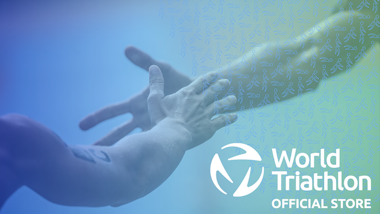World Triathlon Paths to Paris: Howie Sanborn
24 May, 2024 | español

Today marks 100 days to go until the triathlon events at the 2024 Paris Paralympic Games and the top Para triathletes in the world are entering their final preparatory stages. One such athlete is Howie Sanborn (USA).
Sanborn is one of several gold medal contenders in the fiercely competitive PTWC class and when he spoke to World Triathlon as part of the ongoing Paths to Paris series he made it clear that this will be an opportunity that he intends to seize with both hands.
It’s all in the arms
Para-triathletes in the wheelchair class face a unique challenge when it comes to training and racing. In all three disciplines the arms are the primary form of locomotion and the race requires a level of strength unfathomable to most triathletes. Within the race, though, there is more than meets the eye. While the swim has the same grounding in technique that confronts any other triathlete, the bike and run are altogether different propositions.
“The bike is the least technical in terms of how you pedal,” explained Sanborn. “How you ride the bike on the course is different but as far as training goes you can sit on the trainer for hours and it’s straight-forward.”
The run is a different beast. Every PTWC race has its own challenge but what unites them is that they are rarely easy. When it comes to pushing the power in the racing chair at the end of a triathlon, it’s all about heart.
“When you get on the racing chair, what I think a lot of people don’t know is that it’s unbelievably technique-based. You require a very specific body position to get the most out of your racing chair. A lot of us are constantly playing with what that looks like and as your body changes through the sport you’re adjusting for that in the chair.”
“It’s the last part of the triathlon but even though your arms are tired it’s requiring you to have perfect form and an unbelievable amount of strength. With the bike you’ve got gears and the ability to shift based on how you want to control that effort. When you’re onto the run, you’re on a fixie at that point and it’s what have you got left? How hard can you go?”
“The guys at the top of the sport in the WC sprint distance, they don’t let off for one second. You can’t take too deep a breath because you’re half a second back and that can lose you the race. It’s all-out for roughly an hour with your arms. That last little bit in the racing chair is head down and hammer.”
The Accident
Determination is a current that flows beneath the surface throughout the conversation with Sanborn. His Path to Paris was originally sparked by an accident, one that he speaks openly about to raise awareness, from his time training for a first Ironman as an age-group racer.
“Myself and a teammate were cycling in the breakdown lane, off the road, and a driver that wasn’t paying attention left the road and hit us from behind. It just speaks to something that’s ongoing right now and is getting worse and worse, you see it all the time.”
“In the blink of an eye, my life changed. It’s something I don’t think anyone wants to live with and it’s something the person receiving the injury doesn’t expect to live with, but you make the best you can with it.” Sanborn paused. “For me, I’ve always been very purpose-driven so I woke up and I was in ICU already looking at hand-cycles. I was like ‘I’m not done’.”
“I went from being a professional skydiver in the army doing air shows all over the country and an airborne ranger with combat time to waking up in a hospital bed. I was like, ‘what can I do next?’”
“It’s not that easy for everybody, and I’m not saying it was easy for me. There are a lot of barriers when it comes to living with a disability and a lot of barriers when it comes to getting into sport, especially Para-triathlon where you have three disciplines and a hand-cycle and a wheelchair and having to bring someone with you to each race.”
Sanborn noted that there are several non-profits in the United States that have been able to help. Nevertheless, at the time of Sanborn’s accident, Para triathlon had not yet been announced as a sport at the 2016 Paralympic Games.
“I looked at everything that had been taken away from me and there were a lot of people that suggested I shouldn’t get back on a bike but I knew the ability to continue my pursuit of triathlon was something I needed to get back and wanted to get back.”
“Inside sport we all know there’s community. Misery loves company. You know those long bike rides and swims and that’s where brother- and sisterhood and community are formed. That’s something I always push people towards.”
Into the fire
Sanborn’s accident came in 2012. Around 8 months later, he took part in his first World Triathlon race. Then, a year later, he raced in his first World Para Series event in Yokohama in 2014.
“A lot of the same guys are still around,” he said. “There’s definitely a community in Para triathlon. When you get to a race, you see each other four or five times a year so it’s super nice to hang out and catch up. There’s definitely fierce competition once the gun goes off but up to that point and then after the race we’re friends. It’s really awesome.”
From his beginnings in Para-triathlon, he has since made over 50 international starts and fought his way to the upper echelons of the sport. Before long, his sights were set on the Tokyo Paralympic Games. However, what was supposed to be a crowning moment in his triathlon career became one of heartbreak as Sanborn missed out on Paralympic qualification.
“I was a resident athlete at the time at the Olympic/Paralympic Training Centre so all my teammates left for Tokyo and I didn’t. That was definitely a bit of a setback.”
In addition, he had bought a bottle of Pappy Van Winkle with a view to opening it to celebrate qualifying for Tokyo. After the Games and for years thereafter, the bottle was left unopened.
The Next Level
After the disappointment of Tokyo, Sanborn has been on a tear. He has won the Americas Championships in each of the three seasons since 2021. Moreover, he won two World Para Series stops last year, in Devonport and Montreal, the former of which was his first ever Series win.
“That was pretty big,” said Sanborn. “I had been racing the guys that were there for probably a decade. We all know each other really well and I had never been close to beating them so to come out on top in Devonport last year was huge.”
“I went into it knowing that it had been a killer off-season. I thought ‘this is the best I’ve ever been, let’s put this down and see what happens’.”
At this moment in time, Sanborn is ranked 2nd in the World Triathlon Paralympic rankings; he was recently knocked off the top spot by Geert Schipper’s victory in Yokohama. Most importantly, his ranking has sealed his ticket to the Paris Paralympic Games.
As a result, an old bottle of Pappy Van Winkle was dusted down and came out of its box.
“After Florida (where the Americas Championships in Miami were held), we got to crack it open and it was really good. All those training sessions where I just had to tell myself when it got hard that ‘this will be worth it, this will be worth it’… then it was.”
A golden summer?
“My coach and I and Team USA have big goals based on my trajectory.”
Without quite spelling it out, Sanborn is clear about what he plans at the Games. Gold is on his mind. At the same time, he faces one of the most competitive classes in all of Para-triathlon. At the 2023 World Championships in Pontevedra, he placed 5th. On the one hand, it represented his best ever result at worlds. On the other, Sanborn hungered for more.
“I was hoping by the end of last year that I would at least be the top H1 and take a run at Giovanni (Achenza) who has just been a stud forever. I wasn’t quite there but I had a really solid race there.”
He noted that the Pontevedra course was interesting with a climb and then a descent into speed bumps. Sanborn himself dropped his chain at one point while other rivals suffered punctures. For instance, Jetze Plat, the Tokyo champion, 2022 world champion and 2023 European champion, got a flat. He would then be stunned by Geert Schipper who came away with the gold.
“It does show he’s (Plat) not unbeatable,” said Sanborn. “Just like the rest of us, there’s things that can happen to him in a race.”
Improvise, overcome, adapt
Sanborn is no stranger to such moments; he won a silver medal at the World Para Series in Yokohama in 2023 with a flat tyre on the bike.
“Man,” started Sanborn before smiling and shaking his head, “Yoko in the rain is a rough course. It’s pretty technical and when you’re on a hand-cycle your view isn’t that great from behind the bars, and then you’re trying to navigate the depth perception of where corners are based on where cones are set up. And then the racing chair, it’s rubber on rubber friction so once it gets wet it’s kind of game over. We put some stuff on it to make it as sticky as possible but it’s still tough.”
“It’s one of those things too where sometimes, when you’re on the bike and it’s a slow week like I had, you just start to wonder if it’s you. After Devonport I was like, ‘I know that I’m a little bit slower than these guys on the swim but I’ll make it up on the bike and then on the bike every lap I could see them getting a little bit further ahead. I just thought ‘what am I doing wrong?’”
“It’s so hard to tell when it’s a flat on the back tyre of a hand-cycle because you can’t really look at it.”
Once through T2, he went as hard as he could and made up ground on the run. With the experience behind him, he is at least prepared for come what may at the Paralympic Games.
Onwards to Paris
Plat, Schipper, Achenza and several more will await Sanborn when he arrives in Paris. Alongside the opposition, the American pointed out the challenge of the course itself.
“We’re going to do half the swim into the current so setting yourself up to take advantage of that, based on your positioning, could make or break your race. In the wheelchair category we’re not done with our arms when we come out of the swim so we’re trying to make sure we’re spreading the load across three sports. You don’t want to get caught up killing yourself in the current when you still have a bike and run to do with your arms.”
Sanborn and the rest of the Para triathlon field did not get to race the swim at the Paris Test Event. He nonetheless got a taste for it in the course familiarizations and he reported that the current “was no joke”.
Whatever happens, though, Sanborn is not underestimating the opportunity. “You don’t know how many shots you’re going to have at a Games. I can say that because I’ve missed one. This might be my one opportunity to go and I’m going to make the most of it.”
Through the litany of challenges in Paris, the men’s PTWC race might simply come down to who can dig the deepest and Howie Sanborn will have little trouble with that. After all, the man with some of the biggest arms in triathlon has no shortage of heart.
tags
Array {tag_name} {/tags}






